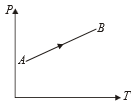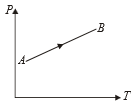The temperature of a hypothetical gas increases to times when compressed adiabatically to half the volume. Its equation can be written as
(1) PV3/2 = constant
(2) PV5/2 = constant
(3) PV7/3 = constant
(4) PV4/3 = constant
एक काल्पनिक गैस का ताप गुना बढ़ जाता है, जब गैस को रुद्धोष्म विधि से संपीडित किया जाता है, जिससे इसका आयतन आधा हो जाता है। इसके समीकरण को लिखा जा सकता है:
(1) PV3/2= नियतांक
(2) PV5/2= नियतांक
(3) PV7/3=नियतांक
(4) PV4/3=नियतांक
When an ideal monoatomic gas is heated at constant pressure, fraction of heat energy supplied which increases the internal energy of gas, is
(1)
(2)
(3)
(4)
जब एक आदर्श एकपरमाणुक गैस को नियत दाब में गर्म किया जाता है, तो आपूर्ति की जाने वाली ऊष्मीय ऊर्जा का वह भाग जो गैस की आंतरिक ऊर्जा को बढ़ाता है,
(1)
(2)
(3)
(4)
Which one of the following gases possesses the largest internal energy?
(1) 2 moles of helium occupying 1m3 at 300 K
(2) 56 kg of nitrogen at Nm–2 and 300 K
(3) 8 grams of oxygen at 8 atm and 300 K
(4) 6 × 1026 molecules of argon occupying 40 m3 at 900 K
निम्नलिखित गैसों में से किसमे सबसे अधिक आंतरिक ऊर्जा है?
(1) 300 K पर 1m3 हीलियम के 2 मोल
(2) Nm–2 और 300K पर नाइट्रोजन के 56 kg
(3) 8 atm और 300K पर ऑक्सीजन के 8 ग्राम
(4) 900 K पर 40 m3 आर्गन के 6 × 1026 अणु
Two samples A and B of a gas initially at the same pressure and temperature are compressed from volume V to V/2 (A isothermally and B adiabatically). The final pressure of A is
(1) Greater than the final pressure of B
(2) Equal to the final pressure of B
(3) Less than the final pressure of B
(4) Twice the final pressure of B
एक गैस के दो नमूने A और B प्रारंभ में समान दाब और तापमान पर आयतन V से V/2 तक (A समतापी विधि से और B रुद्धोष्म विधि से) संपीडित किए जाते है। A का अंतिम दाब है:
(1) B के अंतिम दाब से अधिक है
(2) B के अंतिम दाब से बराबर है
(3) B के अंतिम दाब से कम है
(4) B के अंतिम दाब से दो गुना है
A thermodynamic process is shown in the figure. The pressures and volumes corresponding to some points in the figure are : and . In process AB, 600 J of heat is added to the system and in process BC, 200 J of heat is added to the system. The change in internal energy of the system in process AC would be
(1) 560 J
(2) 800 J
(3) 600 J
(4) 640 J
एक ऊष्मागतिकीय प्रक्रम को चित्र में दिखाया गया है। चित्र में कुछ बिंदुओं के संगत दाब और आयतन हैं: और । AB प्रक्रम में, 600 J ऊष्मा प्रदान की जाती है और BC प्रक्रम में 200 J ऊष्मा प्रदान की जाती है। प्रक्रम AC में निकाय की आंतरिक ऊर्जा में परिवर्तन होगा:
(1) 560 J
(2) 800 J
(3) 600 J
(4) 640 J
Thermodynamic process are indicated in the following diagram
Match the following:
column-I column-II
P. Process-I (a) Adiabatic
Q. Process-II (b) Isobaric
R. Process-III (c) Isochoric
S. Process-IV (d) Isothermal
(a)
(b)
(c)
(d)
ऊष्मागतिक प्रक्रम निम्न आरेख में इंगित किये गए हैं
निम्नलिखित को मिलाएं:
स्तंभ-I स्तंभ-II
P. प्रक्रम- I (a) रुद्धोष्म
Q. प्रक्रम- II (b) समदाबीय
R. प्रक्रम- III (c) समआयतनिक
S. प्रक्रम- IV (d) समतापीय
(a)
(b)
(c)
(d)
A cyclic process ABCD is shown in the P-V diagram. Which of the following P-T curves represent the same process ?
(1)
(2)
(3)
(4)
P-V आरेख में एक चक्रीय प्रक्रम ABCD दिखाया गया है। निम्नलिखित में से कौन-सा P-T वक्र समान प्रक्रम प्रदर्शित करता है?
(1)
(2)
(3)
(4)
The variation of pressure versus temperature of an ideal gas is shown in the given diagram. From this diagram, one can conclude that

1. Volume increases continuously
2. Volume decreases continuously
3. Volume first increases then decreases
4. Volume first decreases, then increase
एक आदर्श गैस के दाब व तापमान के परिवर्तन को दिए गए आरेख में दिखाया गया है। इस आरेख से, यह निष्कर्ष निकाला जा सकता है कि:

1. आयतन लगातार बढ़ता है
2. आयतन लगातार घटता है
3. आयतन पहले बढ़ता है, फिर घटता है
4. आयतन पहले घटता है, फिर बढ़ता है
A sink, that is the system where heat is rejected, is essential for the conversion of heat into work. From which law the above inference follows?
(1) zeroth
(2) First
(3) Second
(4) Third
एक अभिगम, वह निकाय है जहां ऊष्मा को निष्काषित कर दिया जाता है, ऊष्मा को कार्य में परिवर्तित करने के लिए आवश्यक है। उपरोक्त निष्कर्ष किस नियम का अनुसरण करता है?
(1) शून्य
(2) प्रथम
(3) द्वितीय
(4) तृतीय
The temperature inside a refrigerator is and the room temperature is . The amount of heat delivered to the room for each joule of electrical energy consumed ideally will be -
1.
2.
3.
4.
एक प्रशीतक/रेफ्रिजरेटर के अंदर का तापमान है और कमरे का तापमान है। आदर्श रूप से प्रयुक्त विद्युत ऊर्जा के प्रत्येक जूल के लिए कमरे को प्रदत्त ऊष्मा की मात्रा होगी -
1.
2.
3.
4.













